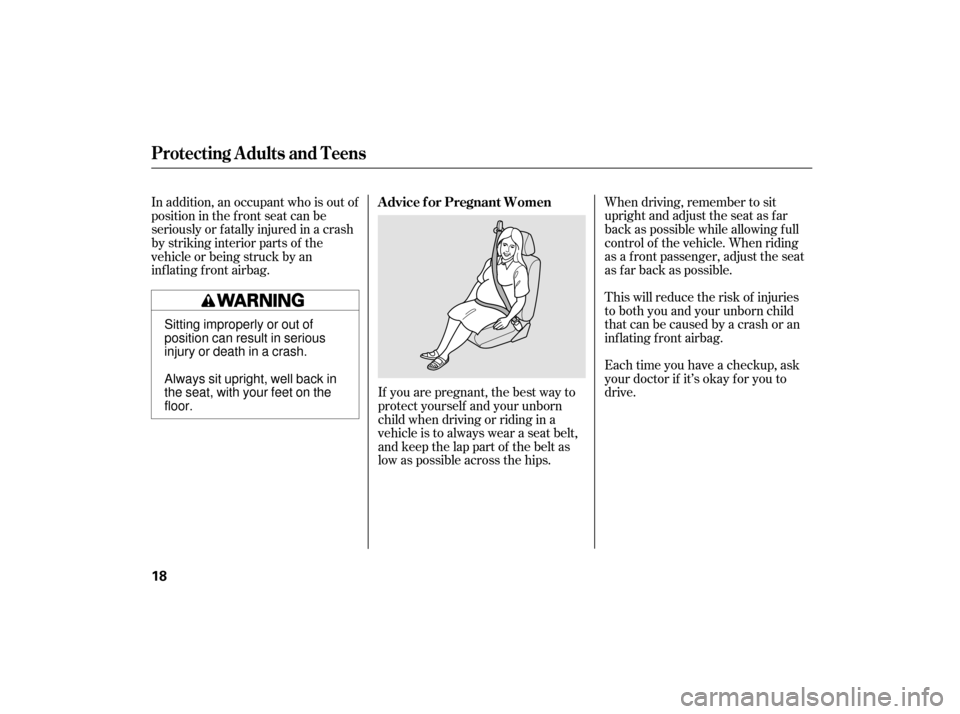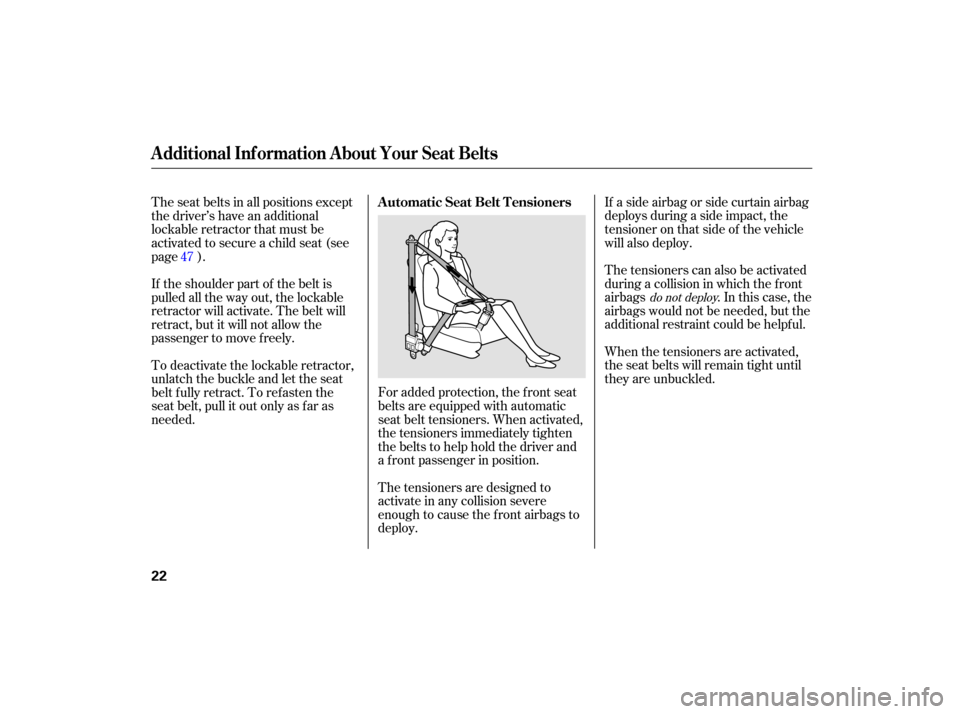Page 15 of 287

The most important things you need
to know about your airbags are:Always wear
your seat belt properly, and sit
upright and as f ar back f rom the
steering wheel as possible while
allowing f ull control of the vehicle. A
f ront passenger should move their
seat as far back from the dashboard
as possible. The rest of this section gives more
detailed inf ormation about how you
can maximize your saf ety.
Remember, however, that no saf ety
system can prevent all injuries or
deaths that can occur in a severe
crash, even when seat belts are
properly worn and the airbags deploy.
They are designed to supplement
the seat belts.
To do their job, airbags must
inf late with tremendous f orce. So
while airbags help save lives, they
can cause minor injuries or more
serious or even fatal injuries if
occupants are not properly
restrained or sitting properly.
Your Vehicle’s Saf ety Features
What you should do:
Airbags do not replace seat belts.
A irbags of f er no prot ect ion in rearimpact s, or minor f ront al or sidecollisions.
Airbags can pose serious hazards.
12
06/08/08 14:16:51 31SDR620_017
Page 17 of 287

If you sit too close to the steering
wheel or dashboard, you can be
seriously injured by an inf lating f ront
airbag, or by striking the steering
wheel or dashboard.Adjust the driver’s seat-back to a
comf ortable, upright position,
leaving ample space between your
chest and the airbag cover in the
center of the steering wheel.
Passengers with adjustable seat-
backs should also adjust their seat-
back to a comf ortable, upright
position.
If you cannot get f ar enough away
f rom the steering wheel and still
reach the controls, we recommend
that you investigate whether some
type of adaptive equipment may help. Af ter the passenger’s seat is
adjusted correctly, it should be
rocked back and f orth to make sure
it is locked in position.
See page f or how to adjust the
f ront seats.
The National Highway Traffic Safety
Administration and Transport
Canada recommend that drivers
allow at least 10 inches (25 cm)
between the center of the steering
wheel and the chest. In addition to
adjusting the seat, you can adjust the
steering wheel up and down, and in
and out (seepage).
80
90
Protecting A dults and Teens
Adjust the Seat-Backs
3.
14
Sitting too close to a front
airbag can result in serious
injury or death if the front
airbags inflate.
Always sit as far back from the
front airbags as possible.
06/08/08 14:17:16 31SDR620_019
Page 21 of 287

When driving, remember to sit
upright and adjust the seat as f ar
back as possible while allowing f ull
control of the vehicle. When riding
as a f ront passenger, adjust the seat
as far back as possible.
This will reduce the risk of injuries
to both you and your unborn child
that can be caused by a crash or an
inflating front airbag.
Each time you have a checkup, ask
your doctor if it’s okay f or you to
drive.
If you are pregnant, the best way to
protect yourself and your unborn
child when driving or riding in a
vehicle is to always wear a seat belt,
and keep the lap part of the belt as
low as possible across the hips.
In addition, an occupant who is out of
position in the f ront seat can be
seriously or f atally injured in a crash
by striking interior parts of the
vehicle or being struck by an
inflating front airbag.
Protecting A dults and Teens
Advice f or Pregnant Women
18
Sitting improperly or out of
position can result in serious
injury or death in a crash.
Always sit upright, well back in
the seat, with your feet on the
floor.
06/08/08 14:17:56 31SDR620_023
Page 22 of 287

If your
hands or arms are close to an
airbag cover, they could be injured
if the airbag inf lates.
Objects on
the covers marked ‘‘SRS AIRBAG’’
could interf ere with the proper
operation of the airbags or be
propelled inside the vehicle and
hurt someone if the airbags inf late.
If they do, they
could be very seriously injured in a
crash.
Carrying hard or sharp
objects on your lap, or driving with
a pipe or other sharp object in
your mouth, can result in injuries
if your f ront airbag inf lates. Devices intended to improve
occupant comf ort or reposition the
shoulder part of a seat belt can
reduce the protective capability of
thebeltandincreasethechanceof
serious injury in a crash.
If a side airbag or a
side curtain airbag inf lates, a cup
holder or other hard object
attached on or near the door could
be propelled inside the vehicle and
hurt someone.
Protecting A dults and Teens
K eep your hands and arms away
f rom t he airbag covers.
Do not at t ach or place object s onthe f ront airbag covers.
T wo people should never use t he
same seat belt .
Do not place hard or sharp object sbet ween yourself and a f rontairbag.
Do not put any accessories on seat
belts.
Do not at t ach hard object s on ornear a door.Additional Saf ety Precautions
Driver and Passenger Saf ety
19
06/08/08 14:18:04 31SDR620_024
Page 23 of 287

Your seat belt system includes lap/
shoulder belts in all f ive seating
positions. The f ront seat belts are
also equipped with automatic seat
belt tensioners.This system monitors the f ront seat
belts. If you turn the ignition switch
to the ON (II) position bef ore your
seat belt is f astened, the beeper will
sound and the indicator will f lash. If
your seat belt is not f astened bef ore
the beeper stops, the indicator will
stop f lashing but remain on.
This system uses the same sensors
as the front airbags to monitor
whether the f ront seat belts are
latched or unlatched, and how much
weight is on the f ront passenger’s
seat (see pages and ).
The seat belt system
includes an indicator on the
instrument panel and a beeper to
remind you and your passengers to
f asten your seat belts. If a f ront passenger does not f asten
their seat belt, the indicator will
come on about 6 seconds af ter the
ignition switch is turned to the ON
(II) position.
If either the driver or a f ront
passenger does not f asten their seat
belt while driving, the beeper will
sound and the indicator will f lash
again at regular intervals.
When no one is sitting in the f ront
passenger’s seat, or a child or small
adult is riding there, the indicator
should not come on and the beeper
should not sound.
28 29
Additional Inf ormation About Your Seat Belts
Seat Belt System Components
20
06/08/08 14:18:12 31SDR620_025
Page 25 of 287

If a side airbag or side curtain airbag
deploys during a side impact, the
tensioner on that side of the vehicle
will also deploy.
The tensioners can also be activated
during a collision in which the f ront
airbags . In this case, the
airbags would not be needed, but the
additional restraint could be helpf ul.
When the tensioners are activated,
the seat belts will remain tight until
they are unbuckled.
The tensioners are designed to
activate in any collision severe
enough to cause the f ront airbags to
deploy. For added protection, the f ront seat
belts are equipped with automatic
seat belt tensioners. When activated,
the tensioners immediately tighten
the belts to help hold the driver and
a f ront passenger in position.
The seat belts in all positions except
the driver’s have an additional
lockable retractor that must be
activated to secure a child seat (see
page ).
If the shoulder part of the belt is
pulled all the way out, the lockable
retractor will activate. The belt will
retract, but it will not allow the
passenger to move f reely.
To deactivate the lockable retractor,
unlatch the buckle and let the seat
belt fully retract. To refasten the
seat belt, pull it out only as f ar as
needed.
47
do not deploy
Additional Inf ormation About Your Seat Belts
A utomatic Seat Belt T ensioners
22
06/08/08 14:18:33 31SDR620_027
Page 27 of 287

Your airbag system includes:Two SRS (supplemental restraint
system) f ront airbags. The driver’s
airbag is stored in the center of
the steering wheel; the f ront
passenger’sairbagisstoredinthe
dashboard. Both are marked ‘‘SRS
AIRBAG’’ (see page ).
Two side airbags, one f or the
driver and one f or a f ront
passenger. The airbags are stored
in the outer edges of the seat-
backs. Both are marked ‘‘SIDE
AIRBAG’’ (see page ).
Two side curtain airbags, one f or
each side of the vehicle. The
airbags are stored in the ceiling
above the side windows. The front
and rear pillars are marked ‘‘SIDE
CURTAIN AIRBAG’’ (see page ). 26
29
31
A irbag System Components
Additional Inf ormation About Your Airbags
24
(1)
(2)
(3) (4)(5)
(8)
(7)
(10) (11)
(9)
(6) (4)
(7)
(8)
(5)
(10)
(11) Occupant Position Detection System (OPDS) Sensors (1) Driver’s Airbag
(2) Front Passenger’s Airbag
(3) Control Unit
(4) Front Seat Belt Tensioners
(5) Side Airbags
(6) Driver’s Seat Position Sensor
(7) Front Passenger’s Weight Sensors
(8) Front Impact Sensors
(9) Passenger’s Airbag Off Indicator
(10) Side Impact Sensors
06/08/08 14:18:52 31SDR620_029
Page 28 of 287

Automatic front seat belt
tensioners (see page ).
Sensors that can detect a
moderate to severe front impact or
side impact.
An indicator on the instrument
panel that alerts you that the
passenger’s side airbag has been
turned of f (see page ).
Emergency backup power in case
your vehicle’s electrical system is
disconnected in a crash.
Sensors that can detect whether a
child is in the passenger’s side
airbag path and signal the control
unit to turn the airbag of f (see
page ).
An indicator on the instrument
panel that alerts you to a possible
problem with your airbags,
sensors, or seat belt tensioners
(see page ).
A sophisticated electronic system
that continually monitors and
records inf ormation about the
sensors, the control unit, the
airbag activators, the seat belt
tensioners, and driver and f ront
passenger seat belt use when the
ignition switch is in the ON (II)
position.
Sensors that monitor the weight
on the f ront passenger’s seat. If
the weight is about 65 lbs (29 kg)
or less (the weight of an inf ant or
small child), the passenger’s f ront
airbag will be turned off (see page
).
A driver’s seat position sensor that
monitors the distance of the seat
from the front airbag. If the seat is
too f ar f orward, the airbag will
inf late with less f orce (see page
).
Sensors that can detect whether
the driver’s seat belt and a f ront
passenger’s seat belt is latched or
unlatched (see page ).
An indicator on the dashboard that
alerts you that the passenger’s
f ront airbag has been turned of f
(see page ).
20
22
28
28
31
33
32
30
Additional Inf ormation About Your Airbags
Driver and Passenger Saf ety
25
06/08/08 14:19:03 31SDR620_030